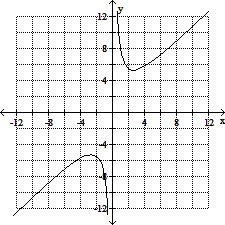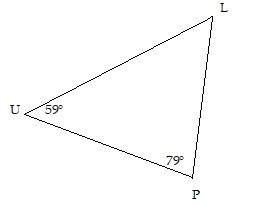Sketch the graph of the function. Indicate where it is increasing and where it is decreasing. Indicate where any relative extrema occur, where asymptotes occur, where the graph is concave up and where is it concave down, where any points of inflection occur, and where any intercepts occur. f(x) = x + 

What will be an ideal response?

Increasing on (-?, - ] and [
] and [ , ?); decreasing on [-
, ?); decreasing on [- , 0) and (0,
, 0) and (0,  ]
]
Relative minimum at ( , 2
, 2 ), relative maximum at (-
), relative maximum at (- , -2
, -2 )
)
Vertical asymptote: x = 0; slant asymptote: y = x
Concave down on (-?, 0); concave up on (0, ?)
No points of inflection
No intercepts
You might also like to view...
Find the indefinite integral.
?

A.
B.
C.
D.
Find the measure of the unknown angle of the triangle.Find the measure of ?L.
A. 101° B. 48° C. 42° D. 121°
Factor.27x3 - 117x2 - 90x
A. x(3x + 2)(9x - 45) B. 9(3x - 2)(x + 5) C. 9x(3x + 2)(x - 5) D. (x2 - 5)(27x + 18)
Solve the problem. Assume that probabilities are representative of the best strategies. Round to two decimal places, if necessary.A company has three different marketing strategies that produce different results depending upon whether inflation is above 6%, between 3% and 6% inclusive, or below 3% annually. Three different experts predict inflation for the next year, but cannot agree. The company's board of directors has three plans of action and will implement one of these. Since the situation has repeated itself for several years, they decide to use game theory to assign probabilities and use these probabilities in making their decision. What is the expected value? The payoff matrix below is in hundred of thousands of dollars. src="https://sciemce.com/media/4/ppg__tttt0626190834__f1q169g1.jpg" style="vertical-align: -32.0px;" />
A. 10.18
B. 49
C. 45
D. 15.54



